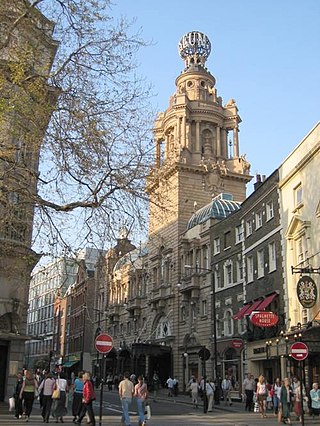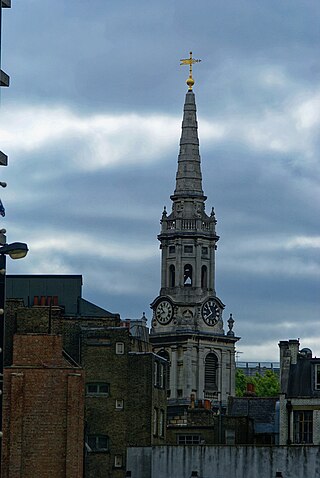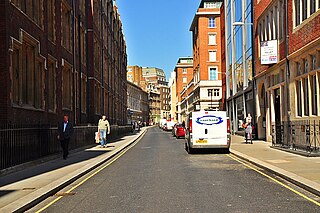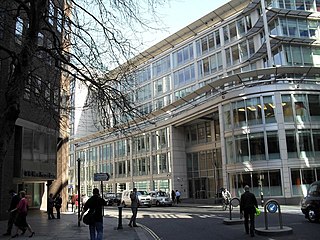

Hanging Sword Alley is an alley in the Alsatia district of London, running between Whitefriars Street and Salisbury Square, close to Fleet Street.


Hanging Sword Alley is an alley in the Alsatia district of London, running between Whitefriars Street and Salisbury Square, close to Fleet Street.
The alley was first known as Ouldwood Alley in the 16th century, when it was in the manor of the Bishop of Salisbury, who owned twenty-four tenements there. [1] [2] It was then named after the sign of a fencing school recorded in 1564, and tuition in this martial art remained in the area until the 17th century. [3] [4]
Walter Bell described the alley as it was at the start of the twentieth century, [5]
Though swept clean, and paved and lighted, Hanging Sword Alley, when you walk its length, gives a fair idea of what the rookeries of Alsatia must have been like. There is scarcely room for two to walk abreast. The exit is by precipitous steps; and the entrance is masked by Crown Court. A line of houses at the south end, with back doors on the alley, open upon Whitefriars Street. The double means of escape well served the purpose of the thieves and rogues who infested the place when pressed in pursuit. There are other steep steps up to Magpie Alley, and the whole neighbourhood of Whitefriars goes up and down in curious fashion, intersected by winding courts like George Yard and Primrose Hill.

In the 18th century, the street became known as Blood Bowl Alley after a night-cellar which was an infamous drinking den. [4] [5]
In 1743, George Morgan encountered a lady in Ludgate Hill and offered to escort her home. The lady, Mary Stansbury, took him to a house in the alley. After some pleasantries and exchange of money, they undressed and went to bed but she then left him to be robbed by a man with a club. Morgan defended himself with his cane and summoned the constable. The Stansburys were tried for assault and the theft of his property: a pair of silver knee-buckles; a pair of silver shoe-buckles; a cambric stock; a bath metal stock-buckle; a silk handkerchief; a hat; a periwig; five moidores; half a guinea and three shillings. Mary Stansbury was sentenced to death for the crime but was reprieved and transported instead. [5] [6] [7]
William Hogarth's 1747 engraving Industry and Idleness portrayed an idle apprentice in Hanging Sword Alley being betrayed by a prostitute who informs of his intent to murder. [3] Dr. Trusler suggested that this was set in Chick Lane but Nichols "was assured that the situation of the night-cellar exhibited in this plate, was in 'Blood Bowl Alley, down by the fishmonger's, near Water-Lane in Fleet-Street'". [8]
Samuel Richardson, author of Pamela , lived close by in Salisbury Court in the 18th century, and ran his printing business from two buildings in the alley. [9] In the 19th century, it appears in Dickens' A Tale of Two Cities as the home of Jerry Cruncher – a porter who moonlighted as a resurrection man, [10] and in his Bleak House , Chapter 27, "More Old Soldiers Than One".[ citation needed ]


Fleet Street is a major street mostly in the City of London, England. It runs west to east from Temple Bar at the boundary with the City of Westminster to Ludgate Circus at the site of the London Wall and the River Fleet from which the street was named.

St Martin's Lane is a street in the City of Westminster, which runs from the church of St Martin-in-the-Fields, after which it is named, near Trafalgar Square northwards to Long Acre. At its northern end, it becomes Monmouth Street. St Martin's Lane and Monmouth Street together form the B404.

The Salisbury Court Theatre was a theatre in 17th-century London. It was in the neighbourhood of Salisbury Court, which was formerly the London residence of the Bishops of Salisbury. Salisbury Court was acquired by Richard Sackville in 1564 during the last seven years of his life when he was Chancellor of the Exchequer under Queen Elizabeth; when Thomas Sackville was created Earl of Dorset in 1604, the building was renamed Dorset House.

The Whitefriars Theatre was a theatre in Jacobean London, in existence from 1608 to the 1620s — about which only limited and sometimes contradictory information survives.

The Wood Street Compter was a small prison within the City of London in England. It was primarily a debtors' prison, and also held people accused of such misdemeanours as public drunkenness, although some wealthier prisoners were able to obtain alcohol through bribery. The prison was built and opened in 1555, replacing the earlier Bread Street Compter, from which many prisoners were transferred. Wood Street was closed and replaced by Giltspur Street Compter in 1791.

St Giles is an area in the West End of London in the London Borough of Camden. It gets its name from the parish church of St Giles in the Fields. The combined parishes of St Giles in the Fields and St George Bloomsbury were administered jointly for many centuries; leading to the conflation of the two, with much or all of St Giles usually taken to be a part of Bloomsbury. Points of interest include the church of St Giles in the Fields, Seven Dials, the Phoenix Garden, and St Giles Circus.

St George Botolph Lane was a church off Eastcheap, in the ward of Billingsgate in the City of London. The rear of the church overlooked Pudding Lane, where the fire of London started. It was first recorded in the twelfth century, and destroyed in the Great Fire of 1666. It was one of the 51 churches rebuilt by the office of Sir Christopher Wren. The church was demolished in 1904.

Chancery Lane is a one-way street situated in the ward of Farringdon Without in the City of London. It has formed the western boundary of the City since 1994, having previously been divided between the City of Westminster and the London Borough of Camden. The route originated as a 'new lane' created by the Knights Templar from their original 'old Temple' on the site of the present Southampton Buildings on Holborn, in order to access to their newly acquired property to the south of Fleet Street sometime before 1161.

Beer Street and Gin Lane are two prints issued in 1751 by English artist William Hogarth in support of what would become the Gin Act. Designed to be viewed alongside each other, they depict the evils of the consumption of gin as a contrast to the merits of drinking beer. At almost the same time and on the same subject, Hogarth's friend Henry Fielding published An Inquiry into the Late Increase in Robbers. Issued together with The Four Stages of Cruelty, the prints continued a movement started in Industry and Idleness, away from depicting the laughable foibles of fashionable society and towards a more cutting satire on the problems of poverty and crime.

Fetter Lane is a street in the ward of Farringdon Without in the City of London, England. It forms part of the A4 road and runs between Fleet Street at its southern end and Holborn.
Whitefriars is an area in the Ward of Farringdon Without in the City of London. Until 1540, it was the site of a Carmelite monastery, from which it gets its name.

The Queen's Head Tavern was located on Fleet Street to the east of the Temple Bar in London. It was already established in 1682 when it is mentioned in the diary of Narcissus Luttrell: "The 2nd, in the morning early, a fire broke out in the back part of the Queen's Head Tavern, by Temple Bar".

Marylebone Lane is one of the original streets of the Marylebone district of the City of Westminster, London. It runs from Oxford Street in the south to Marylebone High Street in the north, its winding shape following the course of the River Tyburn that it once ran alongside and pre-dating the grid pattern of the other streets in the area. Today the lane is largely composed of small shops, cafes and restaurants with some small apartment blocks. There are some larger commercial buildings at the southern end near Oxford Street.

Milford Lane is a narrow street in the City of Westminster that runs from Strand in the north to a brief walkway section leading to Temple Place in the south. It is joined by Little Essex Street and Essex Street on its eastern side. Maltravers Street once joined the lane to Arundel Street, but ceased to exist when building work at 190 Strand was completed.

Cranbourn Street is a street in Central London. It connects Leicester Square to Long Acre via Charing Cross Road.
This is a list of the etymology of street names in the City of London.


Trump Street is a street in the City of London that was originally known as Trumpadere Street, probably after the trumpet or horn makers who once worked there or in the adjacent Trump Alley. It was built after the Great Fire of London (1666) but completely destroyed by bombing during the Second World War and has since been entirely rebuilt.

Seething Lane is a street in the City of London. It connects All Hallows-by-the-Tower, Byward Street, with St Olave's Church, Hart Street. The street is named after an Old English expression meaning "full of chaff", which was derived from the nearby corn market in Fenchurch Street. Samuel Pepys lived there and is buried in St Olave's Church at the junction with Hart Street. A bust of Pepys, created by Karin Jonzen, sits in the public garden at the south end of the street.